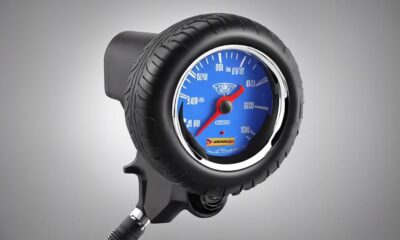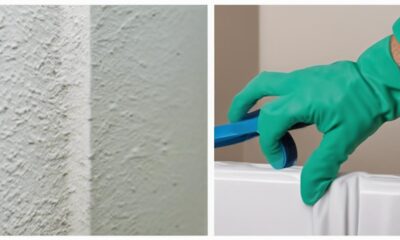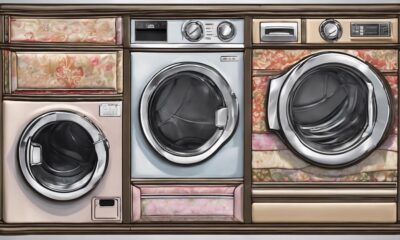Appliances
What Does Winter Mode Mean on a Ceiling Fan?
2025

As the cold sets in and we wrap ourselves in our warmest attire, it’s crucial to ensure our living spaces remain snug and warm. This is the role ‘winter mode’ on a ceiling fan plays.
You see, during colder months, ceiling fans can actually help distribute warm air more efficiently, saving us money on heating bills. In this guide, we'll explore what winter mode means on a ceiling fan and how it works.
We'll also discuss the benefits of using winter mode, how to adjust the fan direction, and tips for maximizing energy efficiency.
So, let's dive in and discover how to make the most of our ceiling fans during the winter season.
Key Takeaways
- Winter mode on a ceiling fan improves comfort and energy efficiency during colder months.
- Activating winter mode causes the fan blades to rotate clockwise at a low speed, distributing warm air that rises to the ceiling back down into the room.
- Winter mode eliminates cold spots and drafts, creating a cozy environment and reducing strain on heating systems.
- Using winter mode on a ceiling fan promotes energy efficiency, lowers heating costs, enhances air circulation, and reduces condensation and mold.
What Is Winter Mode?
Winter mode is a setting on a ceiling fan that's designed to improve comfort and energy efficiency during the colder months. When activated, the fan blades rotate in a clockwise direction at a low speed. This gentle rotation helps to distribute warm air that naturally rises to the ceiling, back down into the room, creating a more even temperature. By optimizing the performance of winter mode, users can experience several benefits.
One of the key benefits of winter mode is improved comfort. As warm air is circulated throughout the room, it eliminates cold spots and drafts, ensuring a cozy environment. Additionally, this setting helps to alleviate the strain on heating systems by reducing the need for constant heating, leading to energy savings.
To optimize the performance of winter mode, it's essential to ensure that the fan is set to the correct speed. A low speed is ideal for this setting, as it allows for gentle air movement without creating a cooling breeze. It's also important to keep the fan blades clean and well-maintained to prevent any disruptions to the airflow.
How Does Winter Mode Work?

When activated, the winter mode setting on a ceiling fan operates by causing the fan blades to rotate in a clockwise direction at a low speed. This rotation creates an updraft, which helps to circulate warm air that rises to the ceiling back down into the room.
Here are five key points to understand how winter mode works on a ceiling fan:
- Efficient Heating: By using the winter mode on your ceiling fan, you can distribute the warm air evenly throughout the room, reducing the need to crank up the thermostat. This can lead to significant energy savings and lower heating costs.
- Adjusting Thermostat: With the warm air being circulated effectively, you may find that you can lower your thermostat by a few degrees without sacrificing comfort. This adjustment can further reduce your heating costs during the winter months.
- Balanced Comfort: Winter mode helps create a more comfortable environment by eliminating cold spots and drafts in the room. The gentle breeze from the fan helps to maintain a consistent temperature throughout the space.
- Condensation Prevention: In addition to circulating warm air, the movement of the fan blades in winter mode also helps to prevent condensation from forming on windows and walls. This can help to maintain a dry and comfortable indoor environment.
- Ease of Use: Most modern ceiling fans come with a reverse switch that allows you to easily switch between the regular mode and winter mode. This makes it convenient to adjust the fan settings based on the season and your comfort needs.
Benefits of Using Winter Mode
Using the winter mode on a ceiling fan offers several benefits for homeowners.
Firstly, it promotes energy efficiency by redistributing warm air that tends to rise to the ceiling, helping to maintain a comfortable temperature and reducing the reliance on heating systems.
Additionally, winter mode enhances air circulation, preventing stagnant air and minimizing the formation of condensation and mold.
Energy Efficiency
To maximize energy efficiency, one can employ the winter mode feature on their ceiling fan. This mode, when activated, can provide several benefits that contribute to reducing energy consumption and saving costs. Here are five energy-saving tips associated with using the winter mode on a ceiling fan:
- Improved air circulation: The winter mode helps circulate warm air trapped near the ceiling, distributing it evenly throughout the room.
- Reduced reliance on heating: By enhancing air circulation, the winter mode allows for better temperature control, reducing the need for additional heating.
- Energy savings: Using the ceiling fan in winter mode can help lower heating costs by up to 15% by maximizing the efficiency of the existing heating system.
- Enhanced comfort: The gentle breeze created by the ceiling fan can make a room feel warmer without increasing the thermostat's temperature.
- Eco-friendly option: By utilizing the ceiling fan's winter mode, you can reduce your carbon footprint by consuming less energy and minimizing your environmental impact.
Improved Air Circulation
One of the key advantages of utilizing the winter mode feature on a ceiling fan is the significant improvement it brings to air circulation throughout the room. When the fan is set to the winter mode, it rotates in the opposite direction compared to the summer mode. This reverse rotation creates an updraft that pushes the warm air near the ceiling downwards, effectively distributing it throughout the space.
This improved air circulation enhances comfort during the colder months, preventing hot air from becoming trapped near the ceiling. Additionally, the enhanced air movement helps to reduce condensation on windows and walls, preventing moisture-related issues such as mold and mildew.
Adjusting the Fan Direction for Winter Mode
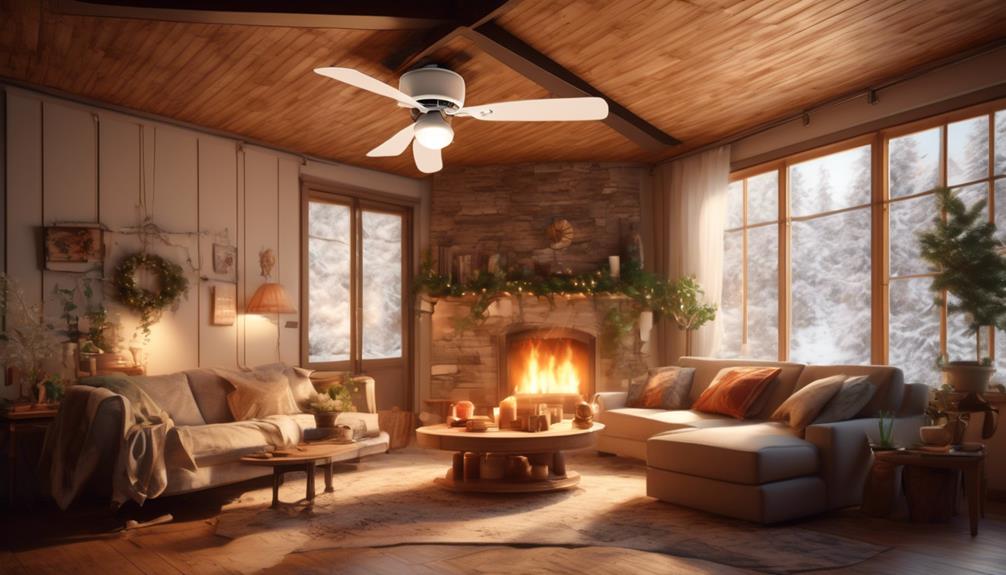
Let's talk about adjusting the fan direction for winter mode.
When it comes to ceiling fans, changing the direction of the fan blades to rotate clockwise during winter can provide several benefits.
Firstly, the clockwise rotation helps to circulate warm air that rises to the ceiling, distributing it evenly throughout the room.
Secondly, adjusting the fan direction in winter can also help save energy by reducing the need for supplemental heating.
Clockwise Rotation Benefits
Adjusting the fan direction to rotate clockwise during winter mode offers several benefits. When the fan rotates clockwise, it creates a gentle updraft that has a significant impact on room temperature. Here are five advantages of clockwise rotation during winter mode:
- Improved heat distribution: The updraft pushes warm air near the ceiling down towards the floor, preventing it from accumulating and creating cold spots.
- Energy efficiency: By redistributing warm air throughout the room, the heater doesn't have to work as hard, leading to potential energy savings.
- Comfortable warmth: The gentle updraft helps maintain a consistent and comfortable temperature, eliminating drafts and cold pockets.
- Reduced condensation: Warm air circulating prevents condensation on windows and walls, reducing the risk of moisture-related issues.
- Cost savings: With improved heat distribution, the need for supplemental heating sources, such as space heaters, may be reduced, resulting in cost savings.
Energy-Saving Benefits
To maximize energy savings, it is advisable to adjust the direction of the fan for winter mode. By doing so, you can not only improve comfort in your home but also achieve significant cost savings. When the fan is set to rotate clockwise during winter mode, it creates an updraft that helps to circulate warm air trapped near the ceiling. This redistribution of warm air throughout the room allows for more efficient heating, reducing the need for excessive use of heating systems. As a result, energy consumption decreases, leading to cost savings on your utility bills. The following table illustrates the energy-saving benefits of adjusting the fan direction for winter mode:
| Fan Direction | Energy-Saving Benefits |
|---|---|
| Clockwise | Improved comfort |
| Cost savings |
Maximizing Energy Efficiency With Winter Mode

How can we enhance energy efficiency during the winter months by utilizing the winter mode feature on a ceiling fan?
Winter mode on a ceiling fan can help maximize comfort and reduce heating bills by efficiently circulating warm air throughout the room.
Here are five ways to maximize energy efficiency with winter mode:
- Reverse the fan direction: The winter mode feature allows the fan blades to rotate clockwise, creating an updraft. This pushes warm air near the ceiling down towards the floor, effectively distributing heat throughout the room.
- Set the fan speed to low: Running the fan on low speed during winter mode can help maintain a gentle and consistent airflow, preventing drafts and reducing the need for additional heating.
- Use in conjunction with heating system: By using the ceiling fan in conjunction with the heating system, warm air can be evenly distributed, reducing the workload on the heating system and potentially lowering energy consumption.
- Adjust thermostat settings: With the proper use of winter mode, you may be able to lower the thermostat temperature by a few degrees without sacrificing comfort. This can significantly reduce heating bills.
- Clean and maintain the fan: Regularly cleaning and maintaining the ceiling fan ensures optimal performance. A clean fan operates more efficiently, maximizing its energy-saving benefits.
How Winter Mode Helps With Heating Efficiency

Utilizing the winter mode feature on a ceiling fan enhances heating efficiency by effectively circulating warm air throughout the room. This feature is designed to optimize the distribution of heat, resulting in heating savings and increased comfort during the colder months.
When the ceiling fan is set to winter mode, it rotates in a clockwise direction at a low speed. This gentle rotation creates an updraft, which helps to disperse the warm air that naturally rises to the ceiling. By pushing the warm air down and circulating it throughout the room, the ceiling fan helps to maintain a consistent temperature and prevent heat from being trapped near the ceiling.
The air circulation benefits of the winter mode feature are twofold. Firstly, it promotes better heat distribution, ensuring that warm air reaches all corners of the room. This eliminates cold spots and prevents the need for excessive heating, resulting in energy savings. Secondly, the circulating air creates a gentle breeze that can make the room feel warmer, allowing occupants to lower the thermostat without sacrificing comfort.
Using Winter Mode to Reduce Heating Costs
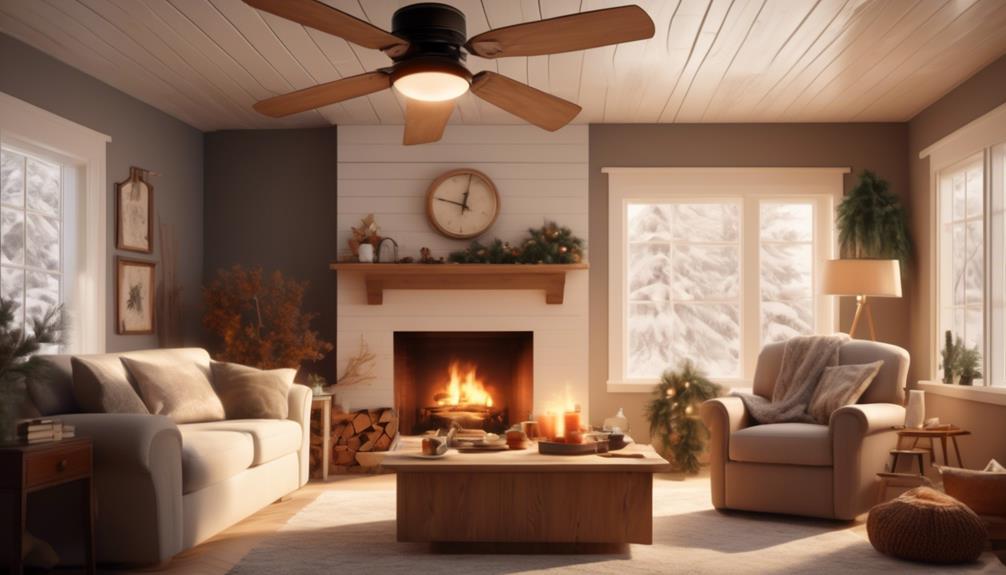
When using Winter Mode on a ceiling fan, there are several energy-saving benefits that can help reduce heating costs.
By running the fan in reverse, it can push warm air that rises to the ceiling back down into the room, improving overall air circulation.
This not only helps to maintain a more comfortable temperature, but it also allows the heating system to work more efficiently, resulting in potential cost savings.
Energy-Saving Benefits
To reduce heating costs during the winter months, homeowners can maximize energy-saving benefits by utilizing the winter mode on their ceiling fan. This feature allows the fan to operate in reverse, pushing warm air down from the ceiling and circulating it throughout the room.
Here are five key benefits of using the winter mode on your ceiling fan:
- Enhanced heat distribution: By running the fan in reverse, warm air is pushed down towards the floor, ensuring more even heat distribution throughout the room.
- Reduced energy consumption: Instead of relying solely on your heating system, utilizing the ceiling fan in winter mode can help you save energy by allowing you to lower your thermostat without sacrificing comfort.
- Increased comfort: The gentle breeze created by the fan in winter mode can make the room feel warmer, reducing the need for additional heating.
- Cost savings: By reducing your reliance on your heating system, utilizing the winter mode on your ceiling fan can lead to significant cost savings on your monthly heating bills.
- Environmentally friendly: Decreasing energy consumption not only benefits your wallet but also contributes to a greener and more sustainable environment.
Improving Air Circulation
Using the winter mode on your ceiling fan can effectively improve air circulation and reduce heating costs.
When the winter mode is activated, the fan blades rotate in a clockwise direction at a low speed. This creates an updraft, which gently pushes warm air that naturally rises towards the ceiling back down to the living space.
By maximizing warmth distribution, the winter mode helps to maintain a consistent and comfortable temperature throughout the room. This is especially beneficial in larger spaces or rooms with high ceilings where warm air tends to accumulate near the ceiling.
Can Winter Mode Be Used With Other Heating Systems?

Winter mode on a ceiling fan can be utilized in conjunction with various heating systems. This feature isn't limited to just one type of heating system, but can be used with different options to enhance their effectiveness. Here are five ways in which winter mode can be combined with other heating systems:
- Using winter mode with central heating: By using winter mode on your ceiling fan, you can help distribute warm air more evenly throughout the room when your central heating system is running. This can prevent hot spots and cold drafts, creating a more comfortable environment.
- Benefits of combining winter mode with a fireplace: If you have a fireplace, using winter mode on your ceiling fan can help circulate the warm air generated by the fire, ensuring it reaches all areas of the room. This can maximize the heating efficiency of your fireplace and keep you cozy during the colder months.
- Pairing winter mode with radiant heating: Radiant heating systems, such as underfloor heating, provide warmth by radiating heat from the floor. By using winter mode on your ceiling fan, you can help distribute this heat more evenly throughout the room, increasing comfort levels.
- Enhancing the efficiency of space heaters: Space heaters are commonly used to provide additional warmth in specific areas. When using a ceiling fan in winter mode alongside a space heater, the warm air can be circulated more effectively, allowing the heat to reach a wider area.
- Improving heat distribution with heat pumps: Heat pumps are energy-efficient heating systems that transfer heat from one place to another. When using winter mode on your ceiling fan in conjunction with a heat pump, the warm air can be evenly distributed throughout the room, maximizing the system's efficiency.
Differentiating Winter Mode From Summer Mode

When differentiating between winter mode and summer mode on a ceiling fan, it's important to understand the distinct functionalities of each setting. Winter mode is designed to maximize energy efficiency by adjusting the fan direction to circulate warm air efficiently throughout a room.
In winter mode, the ceiling fan rotates clockwise at a low speed. This creates an updraft, which pushes the warm air that rises to the ceiling back down to the floor. By redistributing the warm air, winter mode helps to maintain a consistent temperature and reduce the workload on heating systems.
On the other hand, summer mode is used to create a cooling effect by circulating air in a counterclockwise direction. This mode is typically used during the warmer months to create a breeze and provide a cooling sensation.
In summer mode, the ceiling fan rotates at a higher speed, pushing air downwards and creating a wind-chill effect. This can make a room feel cooler without actually lowering the temperature.
Winter Mode and Ceiling Fan Speed Settings

To optimize the performance of a ceiling fan in winter mode, it's important to adjust the speed settings accordingly. The speed at which the fan blades rotate can greatly impact the distribution of warm air in the room. Here are five important considerations when adjusting fan speed for winter mode:
- Slow speed: Set the fan to its lowest speed setting to gently circulate warm air without creating a cooling effect.
- Reverse direction: In winter mode, the fan should rotate in a clockwise direction. This helps to push warm air down from the ceiling and distribute it evenly throughout the room.
- Adjust fan angle: Ensure the fan blades are at a steeper angle to maximize the downward airflow. This helps to prevent the warm air from rising too quickly and getting trapped near the ceiling.
- Use a fan with variable speed control: Invest in a ceiling fan that offers variable speed control. This allows for precise adjustment of the fan speed to suit different temperature conditions.
- Consider room size and temperature: Adjust the fan speed based on the size of the room and the desired temperature. A larger room may require a slightly higher fan speed to effectively distribute warm air.
Tips for Optimizing Winter Mode Performance

For optimal performance in winter mode, it is essential to follow these tips to maximize the efficiency of your ceiling fan. By implementing these strategies, you can ensure that your fan operates at its highest level of performance while also optimizing energy usage.
To assist you in optimizing your ceiling fan's winter mode, we have compiled a table below outlining five key tips:
| Tips for Optimizing Winter Mode Performance |
|---|
| 1. Adjust fan direction to clockwise. |
| 2. Lower fan speed for gentle airflow. |
| 3. Utilize fan in conjunction with heating system. |
| 4. Clean and maintain fan regularly. |
| 5. Consider upgrading to an energy-efficient model. |
To maximize performance, adjust your ceiling fan's direction to clockwise. This will create an updraft, pushing warm air down from the ceiling and circulating it throughout the room. Additionally, lowering the fan speed will provide a gentle airflow that won't create a cooling effect.
Using the ceiling fan in conjunction with your heating system will distribute warm air more efficiently, reducing the workload on your heating system and optimizing energy usage. Remember to clean and maintain your fan regularly to ensure optimal performance.
Frequently Asked Questions About Winter Mode on Ceiling Fans

Many people have questions about how to effectively use the winter mode on their ceiling fans. Here are some frequently asked questions about winter mode on ceiling fans:
- How does the winter mode on a ceiling fan improve heat distribution?
The winter mode on a ceiling fan helps improve heat distribution by pushing warm air that rises to the ceiling back down into the room. This helps to eliminate cold spots and create a more comfortable environment.
- How do I adjust the fan direction for winter mode?
To adjust the fan direction for winter mode, you need to switch the fan's rotation direction to clockwise. This can usually be done using a switch located on the fan's motor housing or with a remote control.
- Can I use the winter mode on my ceiling fan even if I've a heater?
Yes, you can still use the winter mode on your ceiling fan even if you have a heater. The fan can help circulate the warm air produced by the heater, ensuring that it's evenly distributed throughout the room.
- Should I run my ceiling fan in winter mode all the time?
It isn't necessary to run your ceiling fan in winter mode all the time. You can use it intermittently or whenever you feel that the room needs better heat distribution.
- Are there any energy-saving benefits to using the winter mode on a ceiling fan?
Yes, there are energy-saving benefits to using the winter mode on a ceiling fan. By improving heat distribution, the fan helps to reduce the workload on your heating system, potentially lowering energy consumption and costs.
Understanding how to use the winter mode on your ceiling fan effectively can greatly improve heat distribution in your home. By adjusting the fan direction and using it in conjunction with your heater, you can create a more comfortable and energy-efficient living space.
How Does the Yellow Wire in a Ceiling Fan Affect the Winter Mode Setting?
The ceiling fan yellow wire connection is crucial for the winter mode setting. This wire controls the direction of the fan blades, allowing warm air to be pushed downward, which helps to circulate the heat throughout the room. It ensures the fan operates efficiently during the colder months.
Frequently Asked Questions
Can I Use Winter Mode on My Ceiling Fan With a Central Heating System?
Using winter mode on a ceiling fan without central heating may not provide the desired results. In this context, winter mode typically reverses the fan's rotation, pushing warm air down from the ceiling to circulate throughout the room.
Without central heating, the effectiveness of this mode may be limited. However, there are alternative uses for winter mode on a ceiling fan, such as improving air circulation or reducing condensation on windows.
What Are the Different Speed Settings for Winter Mode on a Ceiling Fan?
When it comes to ceiling fan speed settings, winter mode offers distinct benefits.
It's important to understand the different speed settings available for winter mode on a ceiling fan.
By using winter mode, you can help circulate warm air throughout the room, making it more comfortable during colder months.
This can result in energy savings by allowing you to lower the thermostat while still maintaining a cozy environment.
Can Winter Mode Be Used in Conjunction With a Fireplace or Wood-Burning Stove?
Winter mode on a ceiling fan can be used in conjunction with a fireplace or wood-burning stove. However, fireplace safety should always be the top priority. It's important to ensure that the fan is set to the appropriate speed setting for winter mode. This will help distribute warm air efficiently throughout the room.
Additionally, alternative heating options should be considered to supplement the fireplace or wood-burning stove. Space heaters or radiant heating systems can be effective in providing additional warmth.
How Does Winter Mode on a Ceiling Fan Help With Heating Efficiency?
When it comes to heating efficiency, winter mode on a ceiling fan is a game-changer. It's like having a superhero in your house, fighting off the cold and saving energy at the same time.
By running the fan in reverse, it helps to distribute warm air that naturally rises, ensuring that every nook and cranny of your room stays cozy.
This simple yet effective technique can lead to significant energy savings, making winter mode a must-have for those seeking heating mastery.
Are There Any Tips or Tricks for Maximizing the Performance of Winter Mode on a Ceiling Fan?
To maximize the performance of winter mode on a ceiling fan, we can focus on maximizing energy efficiency and adjusting the fan direction.
By using winter mode in a clockwise direction, we can help redistribute warm air that tends to rise towards the ceiling. This can lead to more efficient heating and reduce the need for excessive heating.
Additionally, adjusting the fan speed and using it in conjunction with other heating methods can further enhance its performance in winter mode.
Conclusion
In conclusion, winter mode on a ceiling fan is a feature that helps circulate warm air during colder months. By reversing the fan's direction, it pushes the warm air that rises to the ceiling back down into the room, creating a more comfortable environment and reducing heating costs.
This energy-efficient option is a great addition to any home during the winter season.
- About the Author
- Latest Posts
Introducing Ron, the home decor aficionado at ByRetreat, whose passion for creating beautiful and inviting spaces is at the heart of his work. With his deep knowledge of home decor and his innate sense of style, Ron brings a wealth of expertise and a keen eye for detail to the ByRetreat team.
Ron’s love for home decor goes beyond aesthetics; he understands that our surroundings play a significant role in our overall well-being and productivity. With this in mind, Ron is dedicated to transforming remote workspaces into havens of comfort, functionality, and beauty.
Garage Door Opener
DIY: Install Garage Door Opener Keypad in 10 Steps
Journey into seamless garage access with our 10-step guide to installing a keypad – unlocking convenience at your fingertips.

When it comes to improving the functionality of your garage door system, adding a keypad can offer a convenient way to enter your garage.
However, the process of installing one might seem daunting at first glance. But fear not, as we have broken down the steps into a clear and concise guide that will have you confidently tackling this project in no time.
Stay tuned for essential tips and tricks that will ensure a smooth installation process and have you enjoying the convenience of your newly installed keypad in no time.
Key Takeaways
- Plan and prepare tools and location for keypad installation with attention to accessibility and visibility.
- Protect the keypad from weather elements with proper positioning and a weatherproof cover.
- Program the keypad securely, ensuring alignment and stability for optimal performance.
- Verify wiring connections, test the keypad's functionality, and finalize installation with thorough checks for proper operation.
Gather Required Tools and Materials
To begin the installation process smoothly, ensure we've all the necessary tools and materials at hand, such as a screwdriver, screws, and the keypad itself. When gathering these items, make sure they're compatible with your specific garage door opener model. It's crucial to have everything organized and easily accessible outside the garage where the installation will take place. Check the contents of the keypad box to confirm all components are included, avoiding any setbacks during the setup. Having a stable surface to lay out the tools and materials will facilitate quick access and prevent any potential mishaps.
Proper preparation is key to a successful installation. By ensuring we've the correct tools and materials ready beforehand, we can make the process more efficient and eliminate unnecessary delays. By double-checking and gathering all necessary items outside the garage, we set the stage for a smooth and hassle-free installation of the garage door opener keypad.
Locate the Ideal Placement

When choosing the ideal placement for your garage door opener keypad, we need to consider a few key points.
Ensure the keypad is strategically positioned for easy access by all users, at a comfortable height.
Additionally, think about weather protection to prolong the keypad's lifespan.
Choose Strategic Position
For optimum accessibility and ease of use, position the keypad at a height that caters to both adults and children while ensuring comfortable operation.
When choosing the strategic position for the garage door opener keypad, consider installing it at a level that's easily reachable for all users. Ensure the keypad isn't too high or too low, allowing for convenient operation without straining or bending.
Take note of any potential obstructions or interferences in the selected mounting location to avoid issues with functionality. Additionally, aim to place the keypad in a well-lit area that provides clear visibility for entering the pin code, enhancing user experience and security.
Consider these factors to determine the ideal placement for the keypad to optimize its functionality within your garage.
Ensure Easy Access
Positioning the garage door opener keypad at a height accessible to all users, typically around 5 feet from the ground, ensures convenient and easy access for efficient operation.
Placing the keypad in a well-lit area enhances visibility, especially during nighttime use. Be mindful of obstructions or sharp edges that could obstruct the keypad's functionality and accessibility.
Opt for a location shielded from extreme weather conditions to prolong the keypad's lifespan. Validate the keypad's placement by testing it from various entry angles to guarantee effortless access.
Consider Weather Protection
After ensuring easy access for efficient operation, the next crucial step is to consider weather protection when locating the ideal placement for your garage door opener keypad. To shield the keypad from direct exposure to rain, snow, or extreme weather conditions, it is advisable to install it in a sheltered area. Look for spots under an eave or a covered porch to extend the keypad's lifespan. If mounting the keypad in an exposed area, consider weatherproofing it with a protective cover or housing. Choosing a location that minimizes contact with water and moisture is key to prevent damage and maintain functionality over time. Ensuring weather protection for the keypad is essential for outdoor installations to uphold performance and longevity.
| Placement | Protection |
|---|---|
| Under an eave | Shield from rain and snow |
| Covered porch | Protection from extreme weather |
| Weatherproof cover | Prevent direct exposure to moisture |
Prepare the Keypad Mounting Surface

To ensure a secure and professional installation, start by cleaning the mounting surface with a damp cloth to remove any dirt or debris that may affect the keypad's adherence.
Once the surface is clean, use a level to ensure it's flat before proceeding with the installation. This step is crucial in achieving a polished and secure finish for your keypad.
Additionally, consider using a stud finder to locate and mark the studs on the wall. This will provide added support when mounting the keypad, ensuring it stays securely in place.
It's important to avoid mounting the keypad near any moving parts of the garage door to prevent interference or damage during operation.
Lastly, double-check the mounting surface for stability and suitability before proceeding with the installation to avoid any potential issues down the line.
Following these steps will help you set up your keypad efficiently and effectively.
Install Batteries in the Keypad

Let's start by checking the keypad manual for the specific 9-volt battery needed and opening the battery compartment accordingly.
Make sure to insert the battery following the polarity markings inside the compartment and securely close it for proper functionality.
Testing the keypad afterward will confirm the correct installation of the battery and ensure the keypad is ready for use.
Battery Installation Process
For optimal keypad performance, ensure the correct batteries are installed according to the manufacturer's specifications. Here's how to install the batteries properly:
- Check the Keypad Manual: Look up the specific battery requirements, typically 9-volt or AAA batteries, in the manual.
- Open the Battery Compartment: Use a screwdriver or follow the keypad's sliding mechanism to access the battery compartment.
- Insert Batteries Correctly: Pay attention to the polarity markings inside the compartment and insert the batteries accordingly.
- Securely Close the Compartment: Ensure the battery compartment is closed securely to establish proper connection and functionality.
Remember to replace the batteries periodically to maintain peak performance for your keypad.
Powering Up the Keypad
After successfully installing the batteries in the keypad, the next step is to power up the device by closing the cover securely to ensure proper functionality. To emphasize the importance of battery maintenance and replacement, here is a table outlining key points:
| Battery Maintenance Tips | |
|---|---|
| 1. Check battery life regularly | 2. Ensure proper polarity alignment |
| 3. Replace batteries promptly when low | 4. Avoid mixing old and new batteries |
| 5. Keep the battery compartment clean and dry | |
Following these guidelines will help maintain the keypad's efficiency and prevent operational issues. Remember, a well-powered keypad is essential for seamless garage door opener functionality.
Program the Keypad With Your Opener

To program the keypad with your opener, locate the colored learn button near the motor unit of the garage door opener. Different colors of learn buttons indicate specific programming methods for the keypad. Follow the manufacturer's instructions, as they typically involve a sequence of button presses to initiate programming mode.
Here are the steps to program the keypad accurately:
- Identify the color of the learn button on your garage door opener.
- Enter the programming mode by pressing the designated buttons on the keypad.
- Input a four-digit pin that you'll use to operate the keypad.
- Press the learn button on the garage door opener to synchronize the keypad with the opener.
It is crucial to test the programmed keypad by entering the pin and operating the garage door. This ensures successful synchronization and allows you to verify that the keypad is working correctly with your garage door opener.
Secure the Keypad in Place

Let's ensure the keypad is securely fastened in place by carefully aligning it with the level before tightening the screws evenly. Ensuring the keypad is straight is crucial to prevent any future issues, such as misalignment or difficulties in using the keypad. Here is a handy table to guide you through securing the keypad:
| Step | Action |
|---|---|
| 1 | Use a level to check alignment. |
| 2 | Tighten screws evenly for stability. |
| 3 | Confirm snug fit against the wall. |
Connect the Wiring to the Opener

Let's now tackle the crucial step of connecting the wiring to the opener.
We'll provide an overview of the wiring connections, ensure proper wire termination, and test the connection for functionality.
This process is vital to ensure your keypad communicates effectively with the garage door opener.
Wiring Connections Overview
Before proceeding with the wiring connections for the keypad installation, ensure that the power to the garage door opener is turned off.
Here's an overview of the wiring connections process:
- Identify the terminals on the garage door opener where the keypad wiring will be connected.
- Match the keypad wires to the corresponding terminals on the opener based on the installation instructions.
- Use wire nuts to securely connect the keypad wires to the opener terminals for a reliable connection.
- Double-check the wiring connections to ensure they're properly seated and insulated before restoring power to the opener.
Proper Wire Termination
Have the wire strippers handy to carefully remove the insulation from the ends of the keypad wires before matching them to the corresponding terminals on the garage door opener.
Ensure to match the colors of the keypad wires to the designated terminals on the opener.
Insert each wire into its assigned terminal and securely tighten the screws to establish a reliable connection.
It's crucial to double-check all connections to confirm there are no loose wires or exposed copper, which could lead to electrical hazards.
Adhering to the manufacturer's guidelines for wire termination is essential to prevent any operational issues.
Following these steps diligently will help guarantee a safe and efficient installation of your garage door opener keypad.
Testing the Connection
After securely connecting the keypad wiring to the designated terminals on the garage door opener, the next crucial step is to test the connection to ensure proper functionality before finalizing the installation. Here are four essential steps to follow:
- Activate the Keypad: Press a few random numbers on the keypad to check if the display lights up and responds.
- Test with the Opener: Enter the access code followed by the open/close button to see if the garage door responds accordingly.
- Check for Consistency: Repeat the process multiple times to confirm consistent operation.
- Inspect for Errors: Look for any error codes or unusual behavior during testing to address any potential issues promptly.
Test the Keypad Functionality

To ensure the smooth operation of the keypad, thoroughly test its functionality by pressing all buttons to confirm responsiveness and entering the programmed PIN for seamless garage door control. When testing the keypad, ensure that each button responds promptly and accurately to your touch. Next, input the programmed PIN to verify that the garage door opens and closes as intended. Additionally, check if the keypad illuminates correctly for easy use in different lighting conditions. Look out for any error messages or beeping sounds that could signal problems with programming or connectivity. Evaluate the keypad's range by testing its operation from various distances to guarantee reliable performance.
| Keypad Functionality Test | ||
|---|---|---|
| Button Responsiveness | Programmed PIN Entry | Illumination Check |
| Error Message Detection | Range Evaluation |
Adjust Keypad Settings as Needed

Let's seamlessly continue our installation process by adjusting the keypad settings as needed for added security and convenience. Here are some essential adjustments you may want to consider:
- Change Pin Code: Enhance security by customizing the four-digit pin code on the keypad regularly.
- Customize Features: Take control of additional garage door opener features, such as lights, by customizing the keypad settings to suit your preferences.
- Time Delay Feature: Prevent accidental activation of the garage door opener by setting up a time delay feature on the keypad.
- Vacation Mode: Enable vacation mode on the keypad to disable remote access when you're away for an extended period, enhancing the security of your garage.
Remember to refer to the manufacturer's instructions for adjusting advanced settings on the keypad to ensure optimal performance.
Enjoy Your Newly Installed Keypad

Upon completing the installation of your new keypad, take a moment to familiarize ourselves with its functions and button layout for seamless operation. Understanding how each button corresponds to specific actions will enhance your experience with the keypad.
Test its functionality multiple times to ensure it consistently works as expected. Consider setting up temporary access codes for guests or service providers to make entry more convenient.
It's essential to keep the keypad clean and free from debris to maintain its functionality over time. Remember to note down the keypad's location and pin code for future reference or troubleshooting purposes.
Frequently Asked Questions
Can I Add a Keypad to Existing Garage Door Opener?
Yes, we can add a keypad to an existing garage door opener. It's a straightforward process that enhances security and provides keyless entry.
Keypads work with various garage door opener brands and models. This upgrade is cost-effective and seamlessly integrates into your current setup with proper installation and programming.
Enjoy the convenience and peace of mind that a keypad brings to your garage door system.
Which Is Better Wired or Wireless Garage Door Keypad?
When it comes to choosing between a wired or wireless garage door keypad, it's essential to weigh the pros and cons.
Wired keypads offer reliability without battery reliance, but may need professional installation due to wiring requirements.
On the other hand, wireless keypads provide flexibility and are easier to install DIY.
Understanding your preferences and garage door opener setup will help determine which option suits you best.
Can You Hardwire a Garage Door Keypad?
Yes, we can hardwire a garage door keypad. It involves connecting the keypad directly to the power source of the garage door opener for a reliable power supply. Check the keypad's instructions to confirm hardwiring compatibility and follow the correct steps.
This method offers a more stable power source than batteries, but it may not be essential for all setups. Hardwiring is an option for those seeking a consistent power solution.
Can You Install a Garage Door Opener by Yourself?
Yes, we can install a garage door opener by ourselves. It's a manageable task with the right tools and instructions. Doing it independently can save us money and give us a sense of accomplishment.
Before starting, ensure the opener is compatible with our system. Following step-by-step guides is key to success. With attention to detail and patience, most of us can tackle this project successfully and enjoy the convenience of a keypad entry system.
Conclusion
In conclusion, with our 10-step guide, installing a garage door opener keypad can be a straightforward DIY project that adds convenience to your daily routine.
Remember, 'measure twice, cut once' to ensure accuracy and precision during the installation process.
By following our detailed instructions and taking your time to do it right, you can enjoy the benefits of easy access to your garage with just a few simple clicks.
Happy keypad installing!
- About the Author
- Latest Posts
Introducing Ron, the home decor aficionado at ByRetreat, whose passion for creating beautiful and inviting spaces is at the heart of his work. With his deep knowledge of home decor and his innate sense of style, Ron brings a wealth of expertise and a keen eye for detail to the ByRetreat team.
Ron’s love for home decor goes beyond aesthetics; he understands that our surroundings play a significant role in our overall well-being and productivity. With this in mind, Ron is dedicated to transforming remote workspaces into havens of comfort, functionality, and beauty.
Garage Door Opener
How Much a LiftMaster Garage Door Opener Costs
Unravel the enigmatic world of LiftMaster garage door opener costs, where affordability meets intricate functionality in surprising ways – a revelation awaits beyond.

When exploring the complex balance between cost and quality in the world of LiftMaster garage door openers, individuals may find themselves wading through a variety of choices, each with its own specific price point. The fascinating aspect is uncovering the detailed factors that influence these differing costs, revealing the elements that ultimately impact the financial commitment required.
So, as we embark on unraveling the mystery behind how much a LiftMaster garage door opener truly costs, prepare to uncover a world where functionality meets affordability in unexpected ways.
Key Takeaways
- LiftMaster garage door openers range from $200-$600, with most models priced between $250-$475.
- Features include WiFi connectivity, AC/DC motor options, battery backup, and automatic door locks.
- LiftMaster openers excel in functionality, convenience, and security, offering reliable quality.
- Consider drive mechanism, horsepower, smart capabilities, and installation costs when selecting a LiftMaster opener.
LiftMaster Chain Drive Opener Prices
LiftMaster chain drive garage door openers offer a range of prices, typically spanning from $200 to over $600, with most models priced between $250-$475, catering to various budgets and garage door needs. These openers come equipped with advanced features like WiFi and Smart technology, ensuring seamless integration with modern smart home setups. Customers can choose between models with AC and DC motors, providing options based on power and efficiency requirements. Additionally, the inclusion of battery backup in all 11 chain drive models ensures operation during power outages, adding an extra layer of convenience and security.
The affordability of LiftMaster chain drive openers doesn't compromise on performance. Despite the varying price points, each model is designed to deliver reliable functionality and durability. Factors like horsepower and security features contribute to the overall cost but ensure that customers receive a high-quality product tailored to their specific garage door demands. Noise reduction capabilities further enhance the user experience, making LiftMaster chain drive openers a practical and efficient choice for homeowners seeking a balance between cost and performance.
LiftMaster Belt Drive Opener Costs

Belt drive garage door openers from LiftMaster typically fall within the price range of $300 to $600, offering a balance between cost and performance for homeowners seeking a quieter operation. These openers are known for their smooth operation, making them a popular choice for those looking to reduce noise levels in their garage. Some key features of LiftMaster belt drive openers include rubber belts reinforced with steel, ensuring durability and reliability. Additionally, these models come with extension kits suitable for 8 or 10-foot doors, providing versatility for different garage configurations.
Key Points:
- Quiet Operation: LiftMaster belt drive openers offer a quieter alternative to chain drive models, making them ideal for homes where noise is a concern.
- Smooth Performance: The rubber belt design, reinforced with steel, ensures smooth operation, reducing friction and wear.
- Mid-Range Cost: Priced between $300 and $600, these openers strike a balance between affordability and performance, appealing to homeowners looking for quality at a reasonable price.
LiftMaster Wall-Mount Opener Prices
When considering garage door opener options for your home, wall-mount models from LiftMaster are priced between $500 to $600, offering a space-saving solution designed for high or irregular ceilings. These openers come equipped with features like direct drive operation, WiFi connectivity, and Smart technology, making them a convenient and secure investment for your household. The automatic door lock feature adds an extra layer of security to your garage. Below is a breakdown of LiftMaster wall-mount opener prices:
| Features | Description | Price Range |
|---|---|---|
| Direct Drive | Smooth and quiet operation | $500 – $600 |
| WiFi Connectivity | Control your garage door remotely | $500 – $600 |
| Smart Technology | Integration with smart home systems | $500 – $600 |
| Auto Door Lock | Enhanced security feature | $500 – $600 |
| Space-Saving | Ideal for high ceilings and irregular spaces | $500 – $600 |
LiftMaster Opener Features Breakdown

After exploring the pricing details of the LiftMaster wall-mount opener options, we'll now analyze the specific features that make these garage door openers stand out in the market.
LiftMaster Opener Features Breakdown:
- Smart Technology Integration
LiftMaster garage door openers come equipped with WiFi connectivity, allowing users to operate their doors remotely through smartphones or other smart devices.
- Motor Options
LiftMaster offers a choice between AC and DC motors in their openers, providing users with flexibility based on their specific needs and preferences.
- Enhanced Convenience Features
Features like battery backup ensure that your garage door can still be operated during power outages, while automatic door locks provide added security and peace of mind.
These features set LiftMaster openers apart in terms of functionality, convenience, and security, making them a reliable choice for homeowners looking for a high-quality garage door opener.
Garage Door Opener Buying Guide
What key factors should be considered when selecting a LiftMaster garage door opener? When choosing a LiftMaster garage door opener, several crucial factors should guide your decision-making process. Consider the type of drive mechanism, horsepower, smart capabilities, and installation costs to ensure you select the best opener for your needs. Below is a breakdown of key considerations when purchasing a LiftMaster garage door opener:
| Factors to Consider | Details |
|---|---|
| Drive Mechanism | Choose between chain drive models for affordability or quieter operation with belt drives. |
| Horsepower | Select the right horsepower based on the size and weight of your garage door for optimal performance. |
| Smart Capabilities | Opt for smart garage door openers with built-in Wi-Fi for remote access and integration with your smart home system. |
| Installation Costs | Factor in installation costs, especially for wall-mounted models, to stay within your budget. |
Frequently Asked Questions
What Is the Best Liftmaster Garage Door Opener for 2023?
We recommend the LiftMaster 8550WLB for 2023, known for its quiet operation and advanced features.
It boasts a powerful DC motor, battery backup, and WiFi connectivity for remote control.
With MyQ technology, smartphone integration is seamless, enhancing convenience and security.
This model offers a lifetime warranty on the motor and belt, ensuring durability and peace of mind.
Homeowners seeking a reliable, high-performance garage door opener in 2023 should consider the LiftMaster 8550WLB.
What Is the Average Life of a Liftmaster Garage Door Opener?
We can expect a LiftMaster garage door opener to last about 10-15 years on average. These openers are renowned for their durability and long-lasting performance. Factors like regular maintenance and proper installation can help extend their lifespan.
LiftMaster models are designed to be reliable and robust, capable of handling frequent use over many years. Understanding this average lifespan can assist in planning for future maintenance or replacement needs.
Is Liftmaster a Good Garage Door Opener?
Yes, LiftMaster is a reliable choice for a garage door opener. Its enhanced security features, durable construction, noise reduction technology, and convenient remote operation make it a top contender.
The ability to control it through a mobile app like LiftMaster MyQ adds further convenience. Various models cater to different garage types, ensuring a suitable option for all needs.
Professional installation is recommended for optimal performance, and regular maintenance ensures longevity.
How Much Does It Cost to Install Liftmaster 8500w?
When considering the installation of a LiftMaster 8500W garage door opener, various factors like location, complexity, and additional services can influence costs. It's prudent to seek quotes from different installers to compare prices and service offerings.
Costs typically range from $150 to $350 for professional installation, although DIY installation is an option. However, improper DIY installation might void the warranty. Some professionals include installation costs in the overall opener price.
Conclusion
In conclusion, the cost of a LiftMaster garage door opener can vary depending on the model and features selected.
Like a well-oiled machine, these openers offer a range of options to suit different budgets and needs, from chain drive models to smart technology.
With prices ranging from $200 to $1,000, there's a LiftMaster opener for every garage door, ensuring smooth and reliable operation for years to come.
- About the Author
- Latest Posts
Introducing Ron, the home decor aficionado at ByRetreat, whose passion for creating beautiful and inviting spaces is at the heart of his work. With his deep knowledge of home decor and his innate sense of style, Ron brings a wealth of expertise and a keen eye for detail to the ByRetreat team.
Ron’s love for home decor goes beyond aesthetics; he understands that our surroundings play a significant role in our overall well-being and productivity. With this in mind, Ron is dedicated to transforming remote workspaces into havens of comfort, functionality, and beauty.
Garage Door Opener
10 Easy Steps to Wire Your Liftmaster Garage Door Opener
Unveil the secrets to wiring your Liftmaster garage door opener effortlessly in 10 simple steps – are you ready to upgrade your garage door experience?

On average, a garage door opener typically lasts between 10 and 15 years before it needs to be replaced.
Now, when it comes to wiring your Liftmaster garage door opener, following 10 straightforward steps can make the process seamless and hassle-free.
From gathering the necessary tools to testing the opener's functionality, each step plays a crucial role in ensuring your garage door operates smoothly and securely.
So, are you ready to learn how to wire your Liftmaster garage door opener like a pro?
Key Takeaways
- Safely connect control terminals to your Liftmaster garage door opener for proper functionality.
- Securely wire and test the connections to ensure smooth operation.
- Manage wires using zip ties for a neat appearance and avoid damage.
- Verify safety measures and test the opener thoroughly for safe and efficient use.
Gather Necessary Tools and Materials
To begin the wiring process for your Liftmaster garage door opener, we need to gather the essential tools and materials required for the installation. You'll need a screwdriver to release push-type terminals on the garage door opener. Ensure you have hookup wire with stripped ends ready to connect the opener to external devices.
It's crucial to check the compatibility of your Liftmaster garage door opener with the external device to ensure proper wiring. Have zip ties or cable trunkings on hand to secure and organize the wires for a clean and professional installation. Consider using a small flat-head screwdriver to tighten the wire connections securely at the screw terminals for reliable operation.
Additionally, make sure you have the wall button that comes with the garage door opener, as this will be essential for the wiring process. By having these tools and materials ready, you can proceed with confidence to wire your Liftmaster garage door opener efficiently and effectively.
Turn Off Power to the Garage Door Opener

Let's cut the power to the garage door opener for safety before proceeding with any wiring tasks. To ensure a secure environment, it's essential to close off the power source to the garage door opener. This action prevents accidental activation of the door during the wiring process and mitigates the risk of electric shock or harm to the opener components.
To disconnect the power, either locate the power source and switch it off or unplug the garage door opener entirely. Before commencing any wiring work, it's crucial to confirm that the power is successfully turned off. This can be done by testing the garage door opener to ensure it doesn't respond to any commands.
Identify the Control Terminal on the Opener
Identifying the control terminal on the opener involves locating specific labeled terminals or following the wire path from the wall-mounted button to the motor unit. To find the correct terminal on your LiftMaster garage door opener, follow these steps:
- Check for Labeled Terminals: Older LiftMaster openers may have terminals labeled 1 and 2 for connecting control wires. On Chamberlain, Craftsman, and newer LiftMaster models, look for the left-most red and white terminals.
- Look for BWC Terminals: Some openers may have terminals labeled BWC for connecting control wires. These terminals are also used for controlling the open and close functions of the garage door.
- Follow the Wire Path: Trace the wire from the wall-mounted button to the motor unit. The terminals at the motor end of this wire are likely the control terminals that handle the signal to open and close the garage door.
- Ensure Proper Functionality: Make sure to connect the control wires to the terminals that receive signals from the wall button to ensure the garage door opens and closes correctly.
Connect the Control Wires to the Opener

Begin by securely connecting the control wires to the identified terminals on your LiftMaster opener using a screwdriver. First, release the terminals using the screwdriver to ensure a proper connection.
Strip the ends of the control wires and insert them into the designated terminals. Tighten the terminals to secure the wires in place, preventing any loose connections during operation.
It's crucial to check the wire connections thoroughly to guarantee proper functionality before closing the opener. By following these steps diligently, you'll successfully wire your LiftMaster garage door opener for seamless operation.
Locate the Wall Control Button Wires
To locate the wall control button wires, trace them from the wall-mounted button to the garage door motor unit. It's essential to follow these steps:
- Identify the Wall Button: Start by locating the wall-mounted button that operates the garage door opener. This button is typically placed near the entrance to the house or in the garage itself.
- Follow the Wires: Trace the wires from the wall button towards the garage door motor unit. These wires are crucial for transmitting the signal from the wall button to the opener.
- Check for Terminals: Look for terminals on the garage door motor unit that are designated for connecting the wall control button wires. These terminals can vary based on the opener model.
- Verify the Connection: Once you have located the terminals, visually inspect the wires to ensure they align correctly with the designated terminals on the garage door motor unit. This verification step is crucial for a successful wiring process.
Connect the Wall Control Button Wires

Let's securely connect the wall control button wires to the designated terminals on the garage door opener using a screwdriver. To ensure a proper connection, follow these steps:
- Identify Terminals: Locate the push-type terminals on the garage door motor unit. These are where the wall control button wires will be connected.
- Release Wires: Use the screwdriver to release the terminals. Insert the wires from the wall button into the designated terminals on the opener.
- Secure Connection: Twist the wires together securely before inserting them into the terminals. This ensures proper contact and prevents loose connections.
- Double-Check: Verify that the wires are correctly connected to the terminals. Check for any loose connections or exposed wires.
| Terminal Label | Wire Color | Wall Control Button Wire |
|---|---|---|
| 1 | Red | Red |
| 2 | White | White |
| 3 | Black | Black |
| 4 | Blue | Blue |
Test the Garage Door Opener

Let's make sure the garage door opener functions properly by testing it with the wall button and remote control. Check for any delays or malfunctions in the opener's response to commands.
Additionally, ensure the safety sensors are working correctly by testing their ability to reverse the door when an object is in the way.
Functionality Check
Perform a functionality check on the Liftmaster garage door opener by testing its operation through various methods:
- Press the wall button to ensure smooth opening and closing of the door.
- Test the responsiveness of the opener to remote control signals for consistent operation.
- Verify the proper functioning of the safety sensors by obstructing the door's path to trigger a reversal.
- Listen for any unusual noises or jerky movements during the door's operation to detect potential issues.
Safety Sensor Test
To ensure the safety and proper functioning of the garage door opener, conduct a safety sensor test by obstructing the door's path and verifying immediate reversal upon contact.
Place an object in the door's path and close the garage door. The door should stop and reverse direction as soon as it touches the obstruction. Test both sensor units separately to ensure they function correctly. If the door doesn't reverse upon contact, adjust the sensor alignment.
Keep the sensors clean and free from any debris for accurate testing. Regularly perform this safety sensor test to guarantee that your garage door opener functions safely and effectively.
Secure and Organize the Wires

Let's ensure a tidy wiring setup by using mounting brackets for secure wire guidance. Avoid staples to prevent wire damage and interference, opting for zip ties or cable trunkings for organized management.
For clarity, consider labeling wires and including the power adapter wire in the cable management plan for a neat installation.
Wire Management Tips
For a tidy and efficient wiring setup, utilize mounting brackets to guide the wires down to the motor unit of your Liftmaster garage door opener. Here are some wire management tips to ensure a clean installation:
- Secure wires using zip ties or cable trunkings to prevent interference with the garage door's operation.
- Avoid using staples to secure wires, as they can damage the wires or pose safety hazards.
- Include the power adapter wire in your cable management plans for a tidy setup.
- Ensure all wires are securely fastened and hidden to maintain a clean and professional look in your garage.
Cable Tie Solutions
We secure and organize the wires along the garage door mounting bracket using cable ties for a neat and interference-free wiring setup. Start by gathering all the wires and aligning them neatly along the bracket.
Use cable ties to fasten the wires securely to the bracket at regular intervals, ensuring they aren't too tight to avoid damaging the insulation. By keeping the wires organized and away from moving parts, you prevent interference with the garage door's operation.
Avoid using staples, as they can harm the wires and lead to short circuits. Consider using cable trunkings for added protection and a clean finish. Remember to include the power adapter wire in your cable management plan for a comprehensive and tidy installation.
Labeling for Clarity
To ensure clear identification and organization of wires, label them distinctly with tags or colored tape before securing them along the garage door opener rail or ceiling.
- Attach labels to each wire indicating its specific function or connection point.
- Utilize different colors for wires serving different purposes for easy visual reference.
- Ensure wires are securely fastened using cable clips or adhesive mounts to prevent tangling.
- Keep wires organized and away from moving parts to avoid interference with the door's operation.
Power On the Garage Door Opener

Before proceeding with powering on the garage door opener, ensure that the unit is unplugged and all power sources are switched off to prevent electrical accidents. Here are the steps to follow:
| Step | Action |
|---|---|
| 1. | Unplug the garage door opener from the power source. |
| 2. | Double-check that all switches controlling power to the opener are off. |
| 3. | Disconnect the power cord from the outlet to avoid any potential shocks. |
| 4. | Use a voltage detector to confirm there is no electrical current present. |
Test the Opener's Functionality

After confirming the power source is disconnected, proceed to test the opener's functionality by pressing the wall-mounted button.
- Check for Smooth Operation: Press the wall-mounted button to observe if the garage door opens and closes smoothly without any unusual noises.
- Verify Safety Sensors: Test the safety sensors by obstructing the door's path during closure to ensure they halt the door's movement.
- Inspect for Error Codes: Look for any error codes or blinking lights on the opener that may indicate underlying issues with the system.
- Test Remote Controls: Confirm that the remote controls and keypad entry are functioning correctly with the opener by opening and closing the door using these devices.
Frequently Asked Questions
How Do I Connect My Liftmaster Garage Door Opener?
To connect your LiftMaster garage door opener, follow these steps:
Identify the red and white terminals on the opener. Use a screwdriver to release the tabs and insert the stripped ends of the wires. Connect the wall button wires to the same terminals as the Garadget device. Twist and secure the wires tightly for a secure connection. Double-check the wiring and test the door before finalizing the installation.
It's crucial to follow these steps carefully for a successful setup.
How Many Wires Do You Need for a Garage Door Opener?
We need two wires for a standard garage door opener installation. One wire is for the 'push' or 'close' signal, and the other is for the 'release' or 'open' signal. These wires transmit control signals from the wall button or remote to the garage door opener motor unit.
Understanding the function of each wire is key for effective control system setup. Connecting these wires properly ensures smooth and reliable operation of your LiftMaster garage door opener.
How Do You Wire a Garage Door Opener Button?
We wire a garage door opener button by identifying the appropriate terminals on the opener. Locate and release push-type terminals using a screwdriver. Twist stripped wire ends together for a secure connection. Insert wires into the designated terminals, ensuring a tight fit.
Follow these steps to successfully wire your garage door opener button for seamless operation.
Can You Hardwire a Garage Door Opener?
Yes, we can hardwire a garage door opener by connecting the necessary wires to the designated terminals on the opener. Hardwiring offers a more direct and reliable connection for controlling the garage door opener.
It allows for seamless integration of accessories like keypads, remotes, or smart home systems. Following the manufacturer's guidelines and wiring instructions is crucial for safety and proper functionality.
Hardwiring provides a permanent solution without relying on batteries or wireless signals.
Conclusion
In conclusion, wiring your Liftmaster garage door opener is a simple process that can be completed in just 10 easy steps.
Did you know that properly maintaining your garage door opener can increase the lifespan of the system by up to 50%?
By following these steps and ensuring proper installation, you can enjoy a smooth-functioning garage door opener for years to come.
Happy wiring!
- About the Author
- Latest Posts
Introducing Ron, the home decor aficionado at ByRetreat, whose passion for creating beautiful and inviting spaces is at the heart of his work. With his deep knowledge of home decor and his innate sense of style, Ron brings a wealth of expertise and a keen eye for detail to the ByRetreat team.
Ron’s love for home decor goes beyond aesthetics; he understands that our surroundings play a significant role in our overall well-being and productivity. With this in mind, Ron is dedicated to transforming remote workspaces into havens of comfort, functionality, and beauty.
-

 Decor5 days ago
Decor5 days agoMaximalist Decor Explained: Embrace More Style
-

 Vetted4 weeks ago
Vetted4 weeks ago15 Best Drip Irrigation Systems to Keep Your Garden Thriving
-

 Vetted1 week ago
Vetted1 week ago15 Best Foot Massagers for Neuropathy to Soothe Your Feet and Relieve Discomfort
-

 Vetted2 weeks ago
Vetted2 weeks ago15 Best Sports Laundry Detergents for Keeping Your Activewear Fresh and Clean
-

 Vetted3 weeks ago
Vetted3 weeks ago15 Best Tall Toilets for Seniors That Combine Comfort and Safety
-

 Vetted3 weeks ago
Vetted3 weeks ago15 Best Dish Scrubbers to Keep Your Kitchen Sparkling Clean
-

 Decor3 weeks ago
Decor3 weeks agoWhat Is Eclectic Home Decor
-

 Vetted2 days ago
Vetted2 days ago15 Best Organic Pest Control Solutions for a Naturally Pest-Free Home








